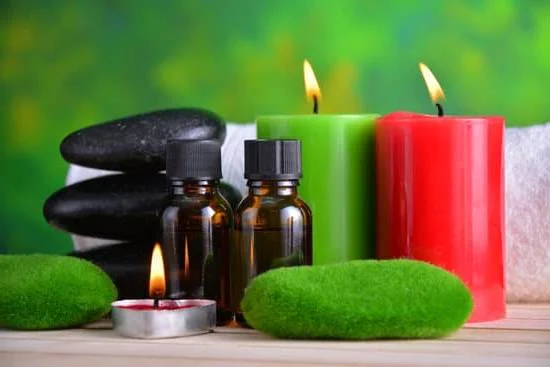How do I make aromatherapy stones that bring a soothing and calming scent to my space? Aromatherapy has long been used as a natural remedy for stress relief, relaxation, and overall well-being.
Aromatherapy stones are an easy and effective way to enjoy the benefits of essential oils throughout the day. In this article, we will explore the concept of aromatherapy stones, the materials needed for making them, and a step-by-step guide on how to create and use these wonderful little creations.
Aromatherapy stones are small, porous stones infused with essential oils that slowly release their fragrance throughout the day. They can be placed in various areas such as your bedroom, living room, or even your office desk to provide a continuous subtle scent. These stones offer all the benefits of aromatherapy in a convenient and long-lasting form.
To make your own aromatherapy stones, you will need a few basic materials and essential oils that suit your preferences. The process is simple yet allows for personalization and creativity to ensure you get the most out of your aromatherapy experience. This article will guide you through everything you need to know about making and using aromatherapy stones for maximum benefits.
Understanding the Materials Needed for Making Aromatherapy Stones
Aromatherapy stones are a wonderful way to enjoy the benefits of essential oils throughout the day. These porous stones absorb and slowly release the aroma of the essential oils, providing a subtle and long-lasting scent. To make your own aromatherapy stones at home, you will need a few key materials. Here is a list of the basic supplies needed to create your own personalized aromatherapy stones:
Materials Needed:
- Base material: The most common base material for aromatherapy stones is either natural clay or air-dry terra cotta clay. These materials are porous and will easily absorb and hold the essential oils.
- Essential oils: Choose high-quality essential oils in your favorite scents. Popular choices include lavender for relaxation, peppermint for energy, and citrus blends for uplifting moods.
- Mixing bowl and spoon: Use a non-metallic mixing bowl and spoon to combine the base material with the essential oils.
- Molds: Depending on your preference, you can use cookie cutters, silicone molds, or simply shape the stones by hand.
- Decorative elements (optional): If desired, gather decorative items such as dried flowers, herbs, or glitter to personalize your aromatherapy stones.
Once you have gathered all these materials, you are ready to start making your own aromatherapy stones at home. Keep reading for a step-by-step guide on how to create these beautiful and functional items that can enhance your well-being on a daily basis.
Step by Step Guide on How to Choose the Right Essential Oils for Aromatherapy Stones
When making aromatherapy stones, choosing the right essential oils is crucial for achieving the desired therapeutic effects. Here are some steps to guide you in selecting the best essential oils for your aromatherapy stones:
1. Consider the intended purpose: Before choosing essential oils, it’s important to consider the specific benefits you want to achieve with your aromatherapy stones. For example, if you’re looking to create calming stones for relaxation, consider essential oils like lavender, chamomile, or bergamot. If you want to make energizing stones, essential oils like peppermint or citrus oils may be more suitable.
2. Research the properties of different essential oils: Each essential oil has its own unique properties and potential benefits. Some essential oils have antibacterial or antifungal properties, while others are known for their calming or uplifting effects. Research the properties of different essential oils to understand how they can support your overall well-being.
3. Test for compatibility: It’s important to ensure that the essential oils you choose are compatible with the base material of your aromatherapy stones. Some essential oils may react differently with certain materials and could affect the quality and texture of your stones.
4. Experiment and customize: Don’t be afraid to experiment with different combinations of essential oils to create a blend that suits your personal preferences. You can also customize your aromatherapy stones by mixing different scents to create a unique and personalized aroma that resonates with you.
By following these steps, you can choose the right essential oils for your aromatherapy stones and enhance their therapeutic benefits according to your needs and preferences.
Detailed Instructions on How to Properly Mix the Essential Oils With the Base Material
Making aromatherapy stones involves the proper mixing of essential oils with the base material to create a fragrant and effective product. The first step in this process is to gather all the necessary materials, which include the base material (such as clay or plaster), essential oils of your choice, a mixing bowl, and a stirring utensil.
It is important to note that different essential oils have different properties and benefits, so it’s crucial to choose the right ones for your specific needs.
Once you have all your materials ready, you can begin the process of mixing the essential oils with the base material. Start by adding a few drops of the chosen essential oil into the mixing bowl containing the base material.
The number of drops will depend on the strength and fragrance you desire, so it’s best to start with a small amount and increase as needed. Then, using a stirring utensil, mix the essential oil into the base material thoroughly until it is evenly distributed.
A helpful tip for properly mixing essential oils with the base material is to use gentle and slow movements to avoid creating air bubbles in the mixture. Air bubbles can affect the overall quality and appearance of your aromatherapy stones.
Additionally, take care not to add too much essential oil, as this can make the mixture too wet and difficult to shape. Once you have achieved an even distribution of essential oil within the base material, you can proceed to shaping and molding your aromatherapy stones according to your preference.
| Materials Needed | Process |
|---|---|
| Base Material (e.g. clay or plaster) | Add a few drops of chosen essential oil into mixing bowl with base material |
| Essential Oils | Mix thoroughly until evenly distributed |
| Mixing Bowl | Avoid creating air bubbles in mixture while using gentle and slow movements |
The Process of Shaping and Molding the Aromatherapy Stones
Creating your own aromatherapy stones can be a fun and creative process, allowing you to personalize your experience with essential oils. The shaping and molding of the stones is an important step in the creation process, as it determines the size, shape, and texture of the final product. Here are some tips and guidelines for shaping and molding your aromatherapy stones.
Choosing the Shape and Size
When it comes to shaping your aromatherapy stones, you have a variety of options to choose from. You can create traditional round or oval shapes, or get more creative with unique shapes such as hearts, stars, or even small animals. Consider what shape would be most practical for the intended use of the stone – for example, smaller, flatter shapes may be more suitable for carrying in a pocket or placing on a desk.
Molding Techniques
There are several different techniques you can use to mold your aromatherapy stones. One popular method is using silicone molds that come in various shapes and sizes. These molds make it easy to create uniform and professional-looking stones. If you prefer a more organic and freeform look, you can also hand-shape your stones using your hands or tools like cookie cutters.
Adding Texture
Adding texture to your aromatherapy stones can enhance their appearance and make them more tactile. You can press objects like lace, leaves, or textured fabric onto the surface of the stones before they dry to create unique patterns. This not only adds visual interest but also provides sensory stimulation when handling the stones.
By carefully considering these factors during the shaping and molding process, you can create beautiful and effective aromatherapy stones that cater to your personal preferences and needs.
Tips for Curing and Drying the Stones Effectively
Choosing the Right Environment
When it comes to curing and drying your aromatherapy stones, it’s important to choose the right environment for the process. A well-ventilated area with low humidity is ideal for allowing the stones to dry effectively. Placing them in a room with good airflow will speed up the curing process and prevent any mold or moisture from developing on the stones.
Patience Is Key
After shaping and molding your aromatherapy stones, it’s crucial to exercise patience during the curing and drying process. Depending on the size and thickness of the stones, it can take anywhere from 24 to 72 hours for them to fully dry. Avoid rushing this step as insufficient drying can lead to cracking or crumbling of the stones once they are ready to be used.
Testing for Dryness
To ensure that your aromatherapy stones are properly dried and cured, you can perform a simple test. Gently press on the surface of the stone – if it feels firm and there are no soft spots, then it is likely fully dried. However, if there is still some give or softness, give the stones some more time to dry before proceeding with decorating or using them in your daily routine.
By following these tips for curing and drying your aromatherapy stones, you can ensure that they are not only visually appealing but also effective in releasing their therapeutic scents when used in aromatherapy practices.
Creative Ideas for Decorating and Personalizing the Aromatherapy Stones
Creating your own aromatherapy stones is a therapeutic and creative activity that allows you to personalize your experience. Once you have made your basic stones, there are endless ways to decorate and personalize them to suit your style and preferences. Aromatherapy stones can be a great way to add a touch of calm and relaxation to your surroundings.
One creative idea for decorating and personalizing aromatherapy stones is by adding color with natural mineral pigments or food coloring. You can mix the pigment or food coloring with the base material before shaping and molding the stones.
This will give them a unique and visually appealing look that complements the fragrance of the essential oils used. Another option is to add dried flowers or herbs into the mixture before shaping the stones, which not only adds a decorative element but also enhances the aromatic experience.
In addition, you can personalize your aromatherapy stones by adding meaningful symbols or letters onto the surface using small stamps or carving tools. This can be a fun way to tailor the stones to specific intentions or affirmations that resonate with you personally. Furthermore, consider adding a finishing touch by sealing the decorated and personalized aromatherapy stones with clear varnish or resin for a polished look and added durability.
Finally, as an alternative to traditional shaping methods, you can use silicone molds in various shapes and sizes to create unique designs such as hearts, stars, or other meaningful symbols. This can make for beautiful personalized gifts for friends and loved ones, allowing you to share the benefits of aromatherapy in a thoughtful and creative way.
| Ideas | Description |
|---|---|
| Add color with natural pigments | Mixing pigment or food coloring with base material for unique aesthetic appeal |
| Add dried flowers/herbs | Enhancing visual appeal and fragrance by incorporating natural elements |
| Personalize with symbols/letters | Adding meaning through customized stamps or carvings on the surface |
How to Use and Incorporate the Aromatherapy Stones Into Your Daily Routine for Maximum Benefits
In conclusion, aromatherapy stones are a wonderful addition to any self-care routine, offering a natural and gentle way to enjoy the benefits of essential oils throughout the day. By following the steps outlined in this article, you can easily create your own customized aromatherapy stones to suit your personal preferences and needs. Not only are these stones simple to make, but they also provide a convenient and effective way to experience aromatherapy wherever you go.
Once you have crafted your aromatherapy stones, it’s important to consider how you will incorporate them into your daily routine. Whether you choose to keep them at your desk, place them in a dish by your bed, or carry them in your purse or pocket, having them nearby will allow you to enjoy their benefits whenever needed.
You may also find that incorporating aromatherapy stones into mindfulness practices such as meditation or yoga can enhance the overall experience and help you achieve a greater sense of relaxation and balance.
As with any wellness practice, using aromatherapy stones is a personal experience, so feel free to experiment and find what works best for you. Whether used for their soothing properties, energizing scents, or simply as a natural air freshener, these little gems have the potential to positively impact various aspects of your daily life.
So why not give it a try? You may find that the simple act of making and using aromatherapy stones becomes a cherished part of your self-care routine.
Frequently Asked Questions
What Are the Ingredients in Aroma Stone?
Aroma stones typically contain ingredients such as plaster of Paris, water, and essential oils. The plaster of Paris is used to create the solid, porous base of the stone, while the essential oils provide the fragrance.
How Do You Make Fragrant Stone?
To make a fragrant stone, you will need to mix together plaster of Paris and water to create a moldable mixture. Then, you can add a few drops of your chosen essential oil to the mixture before shaping it into a stone and allowing it to dry.
What Are Scent Stones Made Of?
Scent stones are commonly made of natural ingredients such as baking soda, cornstarch, and citric acid. These materials help to form a solid yet porous stone that can hold and slowly release the scent of essential oils added to it.

Are you looking for a natural way to improve your health and wellbeing?
If so, aromatherapy may be the answer for you.





